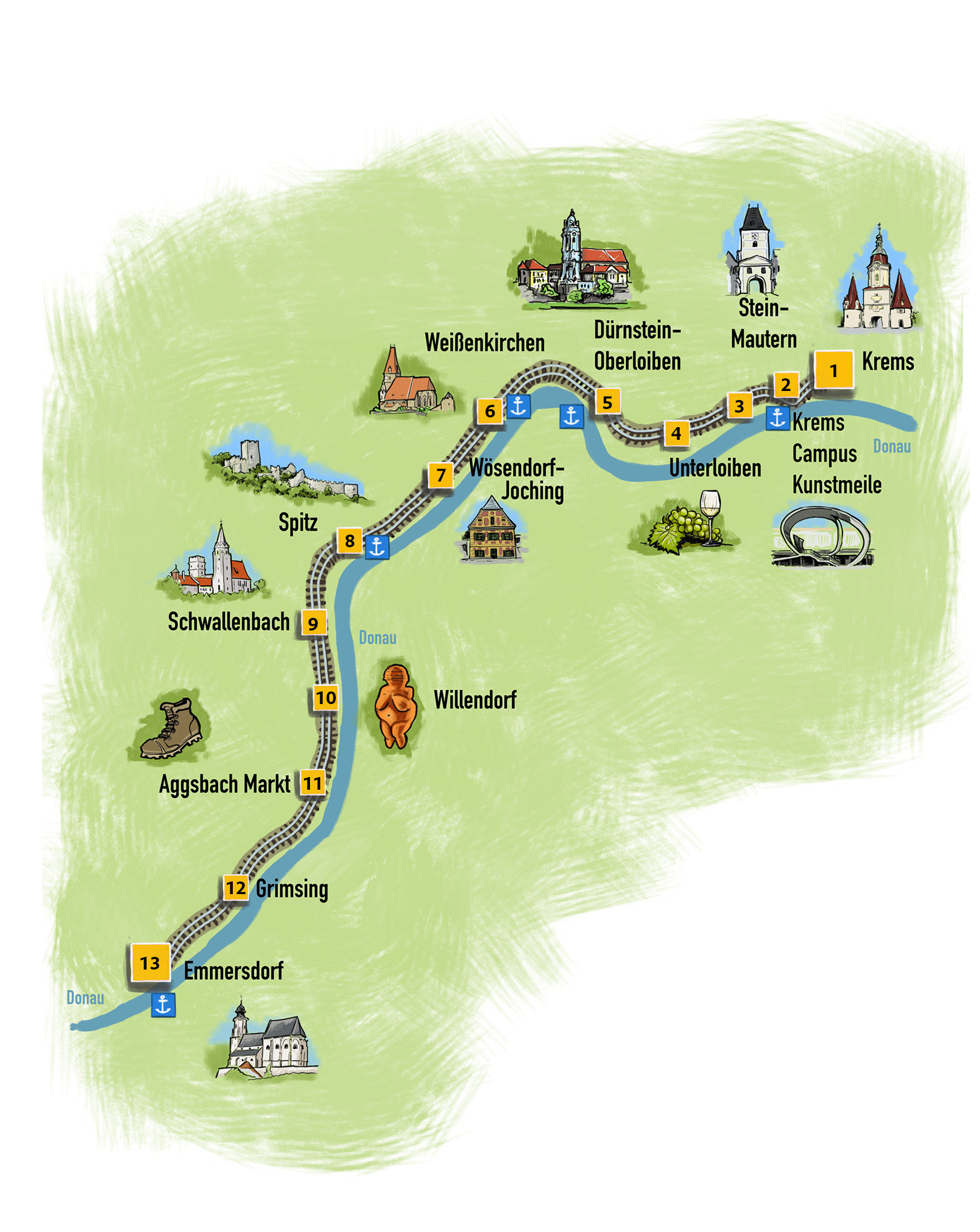Stations
From Krems an der Donau to Emmersdorf
The imposing landscape, atmospheric cultural experience and an extensive network of hiking trails make it easy to get to know and love this region. The Wachau Railway runs through all this variety. Whether your pleasure is nature, culture or sport, there is something for everyone on the Wachau Railway route.

1. Krems an der Donau
At the starting point of the Wachau, on one of the most beautiful sections of the Danube valley, lies the picturesque town of Krems an der Donau. As the gateway to the World Cultural Heritage the more than 1,000 year-old town has succeeded in preserving the historic townscape. Its close connection with viticulture is also reflected in the landscape, the festivals and customs of Krems. In its narrow cobbled alleys, a wide range of culture and cuisine is on offer.
2. Krems Campus - Art Mile
The next stop on the Wachau Railway is directly next to the campus of Krems University. From here in just a few minutes on foot you reach the Art Mile with the Krems Art Gallery, the Caricature Museum and the Lower Austria Regional Gallery.
3. Stein-Mautern
Stein an der Donau is a district of Krems an der Donau and lies on a relatively narrow part of the river bank beneath the terraces, which fall steeply down to the Danube.
4. Unterloiben (request stop)
The next stop is this district of Loiben. Many wine-growers offer traditional specialities. Let them spoil you with a glass of good wine and a tasty snack.
5. Dürnstein-Oberloiben
Dürnstein ‒ an unmissable destination on the bank of the Danube. Here tradition and beauty meet in unrivalled splendour. The former Augustinian monastery of Dürnstein, with its striking bluish white church tower is visible from afar and is deemed to be the emblem of the Wachau.
6. Weißenkirchen in der Wachau
The mighty Gothic parish church of Weißenkirchen in der Wachau rises between sunny vine-covered hills and green forests. The massive tower was originally built for defending against the Turks. Part of the imposing defensive construction is also one of the finest Renaissance courtyards of the Wachau, the Teisenhoferhof. With the wine-growing villages of Joching, Wösendorf and St. Michael, Weißenkirchen forms one of the largest wine-growing municipalities of the Wachau.
7. Wösendorf-Joching (request stop)
In this charming wine-growing village vines are grown not only on terraces, but also on the plain. The Prandtauerhof, which looks back on a 700-year history, is worth a visit.
8. Spitz an der Donau
This village nestles in the midst of vine terraces around the Tausendeimerberg, the Hill of a Thousand Buckets. The old wine-growing village with its Renaissance and Baroque houses, the Late Gothic three-aisled church and the Maritime Museum in the Erlahof invites you to linger.
9. Schwallenbach (request stop)
This district of Spitz an der Donau enchants visitors with its historic stone houses. Enjoy a pleasant stroll through the dream-like alleys.
10. Willendorf in der Wachau (request stop)
The discovery of the famous Venus of Willendorf Stone Age statuette brought fame to this village. Visit the little Venusium Museum and discover more about some of the first sculptures of women in the history of mankind.
11. Aggsbach Markt (request stop)
Because of its location at the foot of the Jauerling, Aggsbach is the ideal departure point for a variety of hiking routes. The sign-posted Summit Circuit is particularly lovely. From the 38-metre high look-out post there is a truly unrivalled view across the region.
12. Grimsing (request stop)
Shortly before reaching the terminus the Wachau Railway halts on request in Grimsing. Take the opportunity to hike the last four kilometres along the Danube to Emmersdorf.
13. Emmersdorf an der Donau
Terminus Emmersdorf an der Donau. The historic centre of this picturesque town enchants its visitors and for centuries has been the inspiration for artists. This is where art and culture simply go together.
